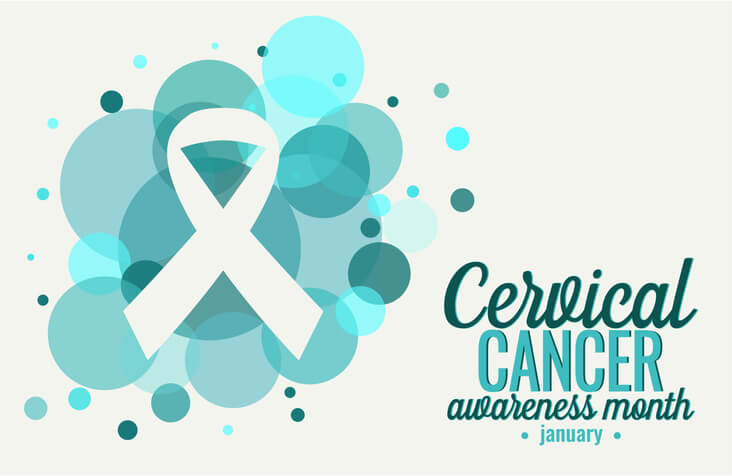
January is Cervical Cancer Awareness Month – Here's What You Need to Know
By Joy Stephenson-Laws, JD, Founder
Many of you, like myself, may not have known that powerhouse sportscaster and Dancing With the Stars contestant Erin Andrews is a survivor of cervical cancer. Reportedly, Andrews was diagnosed back in 2016 and chose to keep this information private at the time. Despite such a scary diagnosis and doctors telling her to take it easy, she continued to work, never missing a football game.
Luckily, her cancer was caught early during a routine gynecological exam.
"I was going to the doctor to get checked every single year. I don’t know if that's something I learned from my mom—she was really good about getting us kids into the dentist and the doctor—but I’m not one that misses an appointment to the gyno. It’s just something that I do every single year,” Andrews said, in this interview from 2018.
“I didn't know anything about cervical cancer before my diagnosis, but now I know that every two hours, a woman dies of cervical cancer. So I would encourage women that they need to get to the doctor. Why? Because it's treatable and it's preventable."
And after undergoing two surgeries, Andrews is now able to say that she is cancer free.
While there has been a dramatic decrease in recent years in the number of women in the United States diagnosed with cervical cancer, the American Cancer Society still estimates that over 13,000 women in this country will learn this year that they have invasive cervical cancer.
Of these, approximately one-third will succumb to the disease. What makes these numbers even more tragic is that the majority of women diagnosed with cervical cancer probably did not know, or learned too late, that cervical cancer is preventable (as Andrews mentioned).
In fact, according to the Centers for Disease Control and Prevention, some 93 percent of cervical cancers could be prevented by screening and HPV (human papillomavirus) vaccination.
(HPV has also been linked to prostate cancer).
Just in case you’re not very familiar with cervical cancer, it, as do other cancers, develops when cells (in this case in the uterine cervix, which connects the uterus to the vagina) grow out of control.
Cervical cancer usually occurs most frequently in women under the age of 50, although around 15 percent of cases are diagnosed in women older than 65. It very rarely, if ever, is diagnosed in women under the age of 20. Cervical cancer also occurs more frequently in Latina/Hispanic women followed by African Americans, Asians, Pacific Islanders and whites. Native American women have the lowest rates of cervical cancer.
African American comedian and actress Yvette Wilson battled cervical cancer. Unfortunately, Wilson reportedly died of the cancer at just 48-years-old.
Prevention is critical when it comes to cervical cancer since, in its early stages, it is usually asymptomatic, which means that your body would not give you any indication that you have it. Unfortunately, a recent study indicated that some 8 million U.S. women ages 21 to 65 reported not having any cervical cancer screening over the past five years. These women are putting themselves at an unnecessary health risk by not doing so since, when found early, many cervical cancers can be cured. If allowed to develop, however, they become increasingly harder to successfully treat.
Vaccination & Screening Go Hand-in-Hand
Since almost all cervical cancers are caused by HPV, the first step to protecting yourself from possibly developing cervical cancer is to get vaccinated against the strains of HPV that have been linked to cervical cancer (different strains can cause other sexually transmitted infections (STIs) such as genital warts).
Out of the some 200 currently identified HPVs, more than 40 HPV types can be easily spread through direct sexual contact, according to the National Cancer Institute. Within the sexually transmitted HPV types, there are low-risk HPVs and high-risk HPVs. There are about a dozen identified high-risk HPV types and two of the them, types 16 and 18, can be connected to most cancers caused by HPV, including cervical cancer.
(According to the CDC, “Condom use may reduce the risk for genital human papillomavirus (HPV) infection and HPV-associated diseases, e.g., genital warts and cervical cancer,” but HPV can affect areas that are not covered by a condom. This is why preventative measures are so important).
Since some strains of HPV are readily transmitted even without sexual activity or contact, the CDC recommends that children, both boys and girls, get vaccinated against HPV between the ages of 11 and 12. This is because research has shown that the vaccine is more effective when given before a child reaches his or her teen years. Because of this, only two doses of the vaccine are needed until 14 years of age; for individuals who are between 15 and 45 years old, three doses are required.
Talk with your doctor about HPV vaccination and about the most appropriate schedule for protecting your children, yourself and other family members against HPV. The sooner you talk with your health practitioner the better, since the vaccine will not protect against cervical cancer among those already infected with HPV. To give you an idea of how common HPV is, estimates are that around 79 million Americans, mostly in their late teens and early 20s (according to the CDC), currently have the virus and many don’t even know it.
The other half of the one-two punch against cervical cancer is testing. The first important test is the Pap smear screening that looks for cancerous and precancerous cells in the cervix. In this test, your doctor or healthcare practitioner takes a sample of cells from your cervix for laboratory analysis and testing. Since there is some difference of opinion on how often a woman should get a Pap smear depending on her age and other factors, you should talk with your doctor to determine how often you should get one.
If you have never had the HPV vaccine, talk with your doctor or another competent healthcare professional about being tested for HPV. And you should still get tested even if you have had the vaccine (getting a vaccine does not mean that you are 100 percent guaranteed to not contract the virus). This test can either be done alone or at the same time you have your regular Pap test. Also check with your insurance company to see if these tests and the HPV vaccine are covered (many insurance companies include them as part of preventative care with no copay).
Other Proactive Steps You Can Take
In addition to the HPV vaccine and Pap smear/HPV testing, there are other things that you can do to reduce your risk of developing cervical cancer. The first is knowing the risk factors for cervical cancer and taking steps to eliminate or reduce them:
- Smoking – If you smoke, you are about twice as likely as non-smokers to get cervical cancer (smoking also makes it harder to fight any HPV infection).
- Weakened immune system – HIV (which drastically affects the immune system) can increase your risk for HPV; this also holds true if you are taking any medications that can suppress your immune response, for example if you have had an organ transplant or are or being treated for an autoimmune disease.
- Having chlamydia – This sexual transmitted infection not only increases the risk for cervical cancer but can also cause pelvic inflammatory disease and infertility if not treated.
- Being overweight – Studies suggesty that overweight women have a higher risk of cervical cancer, along with other obesity-related problems such as hypertension and diabetes.
- Oral contraceptive use – Using oral contraceptives for a long time has been shown to increase cervical cancer risk with the risk increasing the longer you use them – the good news is that this risk starts to drop once you stop using them (interesting to note that using an intrauterine device (IUD) may lower your risk of cervical cancer)
- Multiple births – While no one really knows why, having three or more full-term pregnancies increases the risk of cervical cancer; one theory is that hormonal changes during pregnancy may make you more susceptible to HPV infection or cancer cell growth.
- Early pregnancy – There is evidence that women who had their first full-term pregnancy when they were younger than 17 are almost twice as likely to get cervical cancer later in life, compared to women who have their first full-term pregnancy at 25 or older.
- Family history of cervical cancer – If your mother or sister had cervical cancer, you, unfortunately, have a higher risk of developing the disease – while you can’t do anything about this risk factor, you can keep it in mind as you take other proactive risk reduction steps.
- Unsafe sex, having multiple sexual partners – Not practicing safe sex increases the risk of contracting HPV (along with other STIs), so always use condoms and limit the number of sexual partners.
Another controllable risk factor is poor diet. Current research indicates that women who don’t eat enough fruits and vegetables may be at an increased risk for cervical cancer. This may be more important than you think if you consider that the National Institutes of Health (NIH) reports that 30-40 percent of all cancers can be prevented by lifestyle and dietary measures alone.
For cancer prevention, it is important to get a daily adequate intake of vitamins, minerals and antioxidants, which help reduce the damage from oxidative stress. You should also avoid processed and especially ultra-processed foods since the latter has been associated with a 12 percent increase in the risk for overall cancer.
Other nutrients important for reducing your risk of cervical cancer are folic acid and other B vitamins, which can be found in abundance in leafy green vegetables, salmon, eggs and milk.
Also check out this older pH Labs blog on how eating blueberries may help fight cervical cancer.
Finally, schedule routine nutrient tests in order to identify any nutrient imbalances or deficiencies you may have. Maintaining nutritional balance may reduce the likelihood of cancer and other diseases. If the test reveals you have too much or too little of a certain nutrient, a competent healthcare professional can work with you on making the necessary dietary changes and recommend quality supplements if necessary.
Taking advantage of IV vitamin drips or injections is also a great way to address nutrition imbalance.
Enjoy your healthy life!
The pH professional health care team includes recognized experts from a variety of health care and related disciplines, including physicians, attorneys, nutritionists, nurses and certified fitness instructors. This team also includes the members of the pH Medical Advisory Board, which constantly monitors all pH programs, products and services. To learn more about the pH Medical Advisory Board, click here.







